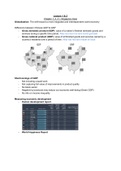Lecture 1 & 2
Chapter 1, 2, 3 + Singapore Case
Globalization: The shift toward a more integrated and interdependent world economy
Difference between Chinese GDP & GNP
- Gross domestic product (GDP): value of a nation’s finished domestic goods and
services during a specific time period. Alles wat door het land wordt gemaakt
- Gross national product (GNP): value of all finished goods and services owned by a
country’s residents over a period of time. Alles wat het land maakt en bezit
Shortcomings of GDP
- Not including unpaid work
- Not capturing full value of improvements in product quality
- No black sector
- Negative by-products may reduce our economic well-being (Green GDP)
- No info on income inequality
Measuring economic development
- Human development report
- World Happiness Report
, - Donut economy
To ensure that no one falls short on life’s essentials (food, healthcare etc), while
ensuring that collectively we do not overshoot our pressure on Earth’s life-supporting
systems, on which we fundamentally depend.
Nominal GDP per capita: nominal GDP divided by population
“Average” per-person output of the economy
→ Is calculated at the current market price
Calculated with inflation
GDP per capita in PPP: GDP adjusted by Purchasing Power Parity divided by total
population.
→ Purchasing Power Parity: Economic productivity and standard of living between
, countries.
→ Compare different countries’ currencies through the ‘basket of goods’ approach
→ Resembles the actual market
GDP at MER: GDP adjusted by observed Market Exchange Rates
E7 - Emerging 7
→ China, India, Brazil, Turkey, Russia, Mexico and Indonesia
G7 - Group of 7
→ Canada, France, Germany, Italy, Japan, United Kingdom and United States
Middle income trap: Concept in which a country that attains a certain income gets stuck at
that level hence hindering development.
Singapore Case
- Has had economic growth since gaining independence in 1965
- Competitive challenges increased since 2000s
→ China and India expanded export and foreign investment
→ Vietnam, Philippines, Malaysia, Thailand and Indonesia increased
competitiveness
Origins of Modern Singapore
- Historically Singapore has been an important trading center
- British East India Company founded modern Singapore.
→ Seek to forestall colonial advanced by the Dutch & France
→ Complement nearby British posts at Penang & Malacca
- Earning revenue through center for trade and transhipment within a year
- Population grew from 150 to 10,700 within five years
- Singapore developed an Entrepot Economy
→ Entrepot Economy = Seaport or warehouse hub. No additional processing
taking place with no customs duties imposed.
1965 - 1970
- Developed a classic Entrepot economy
- Changed power dynamic
- The ‘elite’ group of Singapore had many different functions in the country
- People had to save money (mandatory)
- Government was proactive in planning/organizing infrastructure
- Immediately welcomed FDI
→ Stable exchange rates
, → Limit trade unions (Moderate labor costs)
- Government put a lot of equity stakes in local private companies.
1980’s
- Shift of low wage strategy – high wage strategy
- Shifted attention to higher value, higher productivity products
→ Higher value added
- No governmental support for inefficient firms (might go bankrupt)
→ Skilled workers go to successful companies that can make better use of them.
1990’s & 2000s
- More attention to social & economic growth, infrastructure & institutions
→ Education, advisory body for expatriate Singaporeans, research institutions to
support companies expanding to world markets
- Fundamental economic restructuring
→ Economic Review Committee
→ Deputy prime minister, Several ministers, Chairman Economic
Development board, Secretary general of national trade union congress,
prominent CEOs, chairman of Singapore National Employers Federation
2008
- Aging population
→ Increase in attractiveness of having goods to increase labor pool
- Export was 400% of GDP
- Maintain FDI
- Put economic portfolio into different clusters: Petrochemicals,
Transportation/logistics, Finance & Information Technology
Explanation economic development in Singapore




